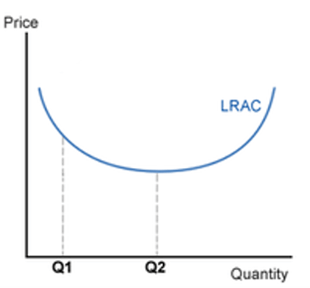Costs are major determinants of pricing since margins need to be maintained. Suppose the firm wishes to reduce selling prices and makeup in a higher quantum, thus achieving economies of large-scale production. This is needed for cash inflow purposes and also to keep inventories moving so that there are no high inventory costs that could cast their shadow on the final profits of the enterprises. When cost curves are declining or tapering, it is possible to pass on a portion of the profits to the consumer through lowered prices. For elastic products, this is indeed good since it would affect demand and supply constructively.
Long-Run Average Costs (LRAC) in the Kingdom of Saudi Arabia
Coming to the market structure of the telecommunication industry in the Kingdom of Saudi Arabia (KSA), it is seen that at the moment, negotiations are on for 2nd fixed-line and third mobile line, as the kingdom is now poised for greater deregularization and liberalization due to its commitment in the WTO membership forums. STC currently holds a major hold over the communication markets, especially in the mobile segment, and Mobily, the second mobile phone provider, would be directly competing with STC in the event the deal is struck in their favor. “Mobily has already spoken of its intentions to begin offering converged services if it is provided with a fixed-line license. This would enable the operator to take advantage of economies of scale, thereby reducing its own costs, and ultimately those of the consumer, which would see its market share increase. However, whether the regulatory body, the CITC, will be willing to offer a license to an operator already present in the market remains to be seen.”
Coming to the mobile segment, it is necessary that mobile operators need to target the younger generation or Third Generation (3G) markets if they wish to seek a niche in this country. Only through more innovative and useful packages and internet provisions in mobiles and other advanced features could it be possible to penetrate and consolidate its position in this competitive and volatile market of KSA. It is necessary that in the context of KSA, both the pricing and features have to be attractive to be accepted. For one thing, “customers will begin to demand a variety of tariffs and at a lower cost as they begin to see neighbouring countries offer their subscribers cheaper rates.”
Thus, the present position in KSA is very akin to what has been commented about the need to keep the cost curve sloping to the right for being able to provide a solid base in this country. Although local mobile and fixed-line operators would be preferred, it is seen that giant telecom firms like AT & T have strategic partnerships in this region should stand their trading partners in good stead.
Typically, it would be the kind of industry and the markets in which they operate that would determine the Long Run Average Costs. (LRAC). During periods of perfect competition, LRAC curves are flatter at the points of equilibrium, and there are constant returns to scale. However, typical LRAC are of the kinds that are up to a point, economies of scale, and if production were to go beyond this point, the diseconomies of scale would result. These need to be guarded against, especially in large multiunit organizations that often take pride in their economies of scale.

The above diagram is an example of a short-range average cost curve. As quantities increase, the prices keep reducing until a stage is reached wherein price-quantity equilibrium is reached. Quantities beyond this point only tend to increase prices.

The diagram above is a representation of the long-range average cost curve. As seen above, Q1 commands a price of say SR10, but when quantities are increased to Q2, the economies of scale move in to reduce the price to SR 7. Up to Q3, pricing may be impacted through long-range average cost. Beyond this point, it is more than the market could bear, and the benefits of large-scale economies cease to be beneficial. Thus, from this stage onwards, the curve slopes upward, indicating higher prices from this point onwards.